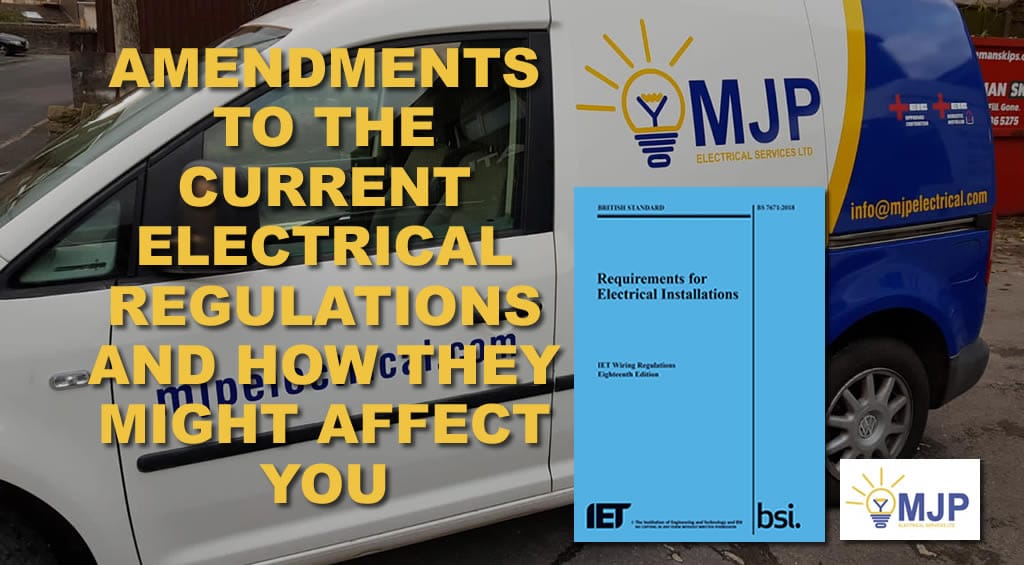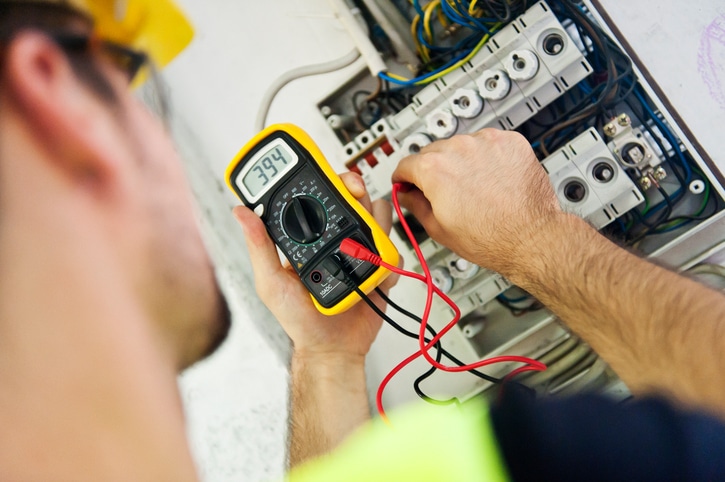It doesn’t take an expert to tell you that electrical safety is of the utmost importance. In the UK, there are several electrical regulations laid out to ensure the safety of electricians, their clients and anyone who uses an electrical circuit. Without these regulations in place, anyone could carry out substandard work with a risk of electric shock, accidents and serious injury.
All good electricians know these regulations and adhere to them. However, there are sometimes updates to these regulations and it’s important to be aware of them. Most recently, we have the Amendment 2 of the 18th edition (BS 7671:2018+A2:2022) and it’s essential to understand how this might affect you.
Largely, this amendment won’t affect domestic properties but relates more closely to places such as HMOs, care homes, student accommodation and other similar settings. In any case, we have put together this information to help you understand clearly what is now expected of you.
What Are The New Amendments?
There have been amendments made to several chapters of the electrical regulations which cover several areas of electrical safety. We’ll take you through each amended chapter and tell you exactly what you need to adhere to.
Chapter 42
Chapter 42 covers protection against thermal effects which could result in a fire. From the moment that electrical installations were first installed in buildings, this has been one of the most important parts of the regulations. In the most recent update, this chapter details requirements that provide protection for property, livestock and people from fires that may break out as a result of electrical equipment. It also covers protections against overheating and burns.
Fires Caused By Electrical Equipment
In part 421.1.7 of the electrical regulations, it has not been changed from a recommendation to a requirement to have an arc fault detection device fitted to final circuits. These are circuits that supply equipment that uses a fixed current and socket outlets. Arc fault detection devices, also known as AFDD’s can sometimes be left out depending on the situation.
For example, you may not need one on a lighting circuit in a dwelling. Moreover, there are some medical locations that have differing requirements. In Groups 1 and 2, AFDDs don’t need to be installed whereas Group 0 would determine the need for an AFDD according to their risk assessment.
However, it is still highly recommended to use one of these devices for optimal protection. Later in this guide, we will look more closely at what an AFDD is, how it works and why it is so important.
Amendments For Precautions Where There Is A Risk Of Fire
Also in the amendments to 422.1, you will notice that it is now a requirement to document any fire safety design features of the building. Furthermore, in 422.2, updates have been added which introduce requirements surrounding protected escape routes during a fire.
Chapter 44
In this section of the electrical regulations, protections against electromagnetic and voltage disturbances are discussed. In this second amendment to edition 18, we see that regulation 443.4 has had a redraft regarding the protection against transient overvoltages and whether they are needed.
Moreover, there have been changes to regulation 443.4.1 which now states that protection against transient overvoltages is required in certain circumstances which could cause either serious injury, loss of life, loss of data or serious financial consequences.
Unless you are dealing with a single dwelling building, a risk assessment must be performed in order to determine the need, or not, for protection against transient overvoltages.
The final amendment to this chapter can be found in regulation 443.4.2 which states that overvoltage protection should be considered where there is equipment that has a high likelihood of producing switching overvoltages. More details of the conditions of this are detailed within the amendment.
Chapter 82
The final, and potentially most detailed amendments to the electrical regulations can be found in chapter 82. This chapter covers a variety of topics including interfacing with the smart grid, energy efficiency, electrical consumption management and renewable energy as well as energy storage.
It’s important to note that this is a very detailed section and the best way to obtain all of the most relevant information is by reading the amendments directly. However, in this section, we aim to bring you the most important aspects of this amendment.
There have been new requirements added to chapter 82 concerning the design, installation and verification of low voltage installations which includes energy production and storage. This ensures correct compatibility with both current and potentially new ways of delivering energy both to the public network and current-using devices. These installations are referred to as prosumers’ electrical installations or PEI’s.
PEI’s are designed with the end user in mind. To demonstrate this, consider a PEI that is able to store energy. This would mean that the end user could benefit from a low demand to store electrical energy at times when the cost is lower. Essentially, this means that the end user has more control over their ability to monitor their energy consumption and production. Not only this, but PEIs mean that we can better use renewable energy sources like wind turbines and store this energy.
When talking about PEIs, there are three different types. These are individual PEIs, collective PEIs and shared PEIs.
Individual PEI's
The individual PEI refers to an installation in a private dwelling or workshop that is able to consume or produce energy. These PEIs can be operated in one of three different ways.
Primarily, there is a direct feeding mode which supplies power to the electrical installation from the grid. Secondly, we have island mode in which the electrical installation relies on power from a generator. Finally, there is reverse feeding mode where the electrical installation puts energy back into the supply network.
Collective PEI's
A collective PEI is a collection of electrical installations that are all connected to one public network and that also share storage equipment and local power supplies. This might include groups of private dwellings or flats, a small group of retail buildings, for example, in a shopping centre and other small groups of properties.
Again, with collective PEIs, there are three different ways of operating and these are the same as before; direct feeding mode, island mode and reverse feeding mode.
Shared PEI's
Once again, the operating methods of a shared PEI are the same as those for individual and collective PEIs. In this case, however, the PEI is based around a group of individual homes which share a supply using a renewable energy source.
Each of the homes within the group may have their own private renewable source and this can supply both the group or the individual property.
Electrical Energy Management Systems For PEI's
A major component of the PEI is an electrical energy management system, known as EEMS for short. The purpose of this system is to be able to control and manage the PEI’s connection to the power grid. This allows better management of the production and consumption of electrical energy.
The way this management takes place is through the use of measuring equipment and metres. These allow information to be sent to the EEMS and direct the flow of energy.
AFDDs and Their Importance
One of the things that have been updated in the electrical regulations 18th edition is the use of AFDD’s is now a requirement as opposed to previously being a recommendation. If you don’t already have these protective devices installed, now is the time to take action. Here, we will cover everything you need to know.
What Do AFDDs Do?
Earlier in this guide, we talked about AFDDs and how they are now required in many situations in accordance with the amendments to the electrical regulations. These are pieces of electrical equipment that are designed to monitor the waves of currents that flow through any given circuit. An AFDD will disconnect the circuit or circuits from power when a fault is detected. Primarily, they’re designed to deal with arc faults.
An arc is something that naturally takes place when an electrical installation is running and they’re utterly normal. However, outside of the normal range, they can be dangerous. Your AFDD is designed to ignore these normal arcs and continue to allow the electrical equipment to work but pick up on anything out of the ordinary.
Also, keep in mind that an AFDD isn’t able to pick up line to earth faults in the way that a circuit breaker or RCD would. Nor can they detect line to neutral faults or overload currents. Your circuit breaker, on the other hand, would, which is why it’s essential to have several protective measures in place for each electrical system.
Another thing to keep in mind with AFDDs is that they are unable to detect problems with a ring circuit. In short, a ring circuit is, as the name would suggest, a circuit that runs in a ring; it begins at your consumer unit and ends there too.
Most UK properties make use of ring circuits but the issue is that there’s no way of knowing if there’s a break in it. If there is, the electricity will simply reverse its direction around the circuit and in no way would attempt to create an arc at the break point. This means that your AFDD would be none the wiser.
Understanding Arc Faults
So if electrical arcing is normal in many cases, what’s the need for an AFDD? Well, the problem is that these arcs can sometimes be outside of the normal range and develop into a fault.
An arc is when the current jumps between two conductive materials. Where the current is quite low, this action causes sparking which usually isn’t much of an issue. However, when the current is much higher, this causes the air to become plasma which will support the electrical arc. What’s shocking about this is that the temperature of these arcs can go up to and beyond six thousand degrees celsius!
It doesn’t take us to tell you that temperatures like this can be incredibly dangerous and could very easily cause a fire to break out.
It’s also worth keeping in mind that there are two main types of electrical arc as follows:
- Parallel arcs are faults that occur between either the earth or neutral conductor and the line conductor. In this case, it won’t only be your AFDD that responds but also your RCD.
- Series arcs are faults that occur within the same conductor among two parts. This could be in a broken line conductor, for example.
Damage That Can Cause Arc Faults
It’s always important to understand how damage to the components of your electrical system could cause problems. Where arc faults are concerned, you will normally find that they happen where there is a loose cable termination or somewhere inside the cable; for example if there is damaged insulation.
Why your cable is damaged could be the result of a number of things and it would be outrageous for us to try and diagnose individual problems in a general blog post like this. However, generally speaking, it could be down to things like screws and nails penetrating the cable, rodent damage or wires that are crushed in some other way.
If you have a loose connection, this is usually because the connection was not sufficiently tightened in the first instance. However, it could also be because of repeated exposure to electromotive force which, over time, can loosen connections.
Won’t My Existing Protection Be Sufficient For Arcing?
In line with the new amendments to the electrical regulations, owners of properties such as youth hostels, HMOs, care homes and other such facilities will need to perform risk assessments in order to determine the need for AFDDs. You could be forgiven for thinking that your existing protective equipment, such as an RCD, would be more than enough to keep your system safe and in good working order.
But this is not the case. Your existing equipment may protect you in many ways but it cannot protect you against arc faults which is why it is so important to think about getting an AFDD installed. With that in mind, let’s look at what protection you’re already afforded with your existing equipment.
To start with, you have basic protection which is as simple as the busbar cover inside the consumer unit and the main cover outside. These are designed to put a barrier between you, the user, and any live parts.
Once you get inside the consumer unit, you will notice that every circuit within the building has its own circuit breaker. These are designed with several purposes in mind. Primarily, they will prevent overloading of the circuit but they also stop short circuiting. This could be caused by water leaking into the system and coming into contact with both the neutral and line conductors, for example. Finally, circuit breakers will detect earth faults.
There is some further additional protection in the form of RCDs. Generally speaking, there should be two of these residual current devices in your home and they will each protect a group of electrical circuits. The main job of the RCD is to respond to line to earth faults.
It’s obvious that modern electrical installations have a good degree of protection as standard so there’s really no need to be concerned when in the home or a commercial building. However, an AFDD gives that extra layer of protection and is essential in line with the amendments that have been made to chapter 42 of the electrical regulations.
Signs To Look Out For If You Don’t Yet Have An AFDD
Since the news of the amendments to the electrical regulations may still be new to you, it can take some time to perform a risk assessment and have the new equipment installed. But that doesn’t mean that you can’t keep yourself as safe as possible in the meantime.
If you are yet to have an AFDD installed, it’s important to keep an eye out for signs that there could be an arc fault within your installation. Let’s take a look at some of the signs you can look out for.
- A burning smell may be omitted from sockets or cables. This doesn’t always signify an arc fault and could be another problem but in any case, it isn’t a good sign and should be dealt with immediately.
- Being incredibly careful, if you notice a burning smell, you can check to see if the cable or socket is hot to touch. If so, you will need to cut the circuit from power and get in touch with your electrician as soon as possible.
- In the case of an arc fault, you may also notice scorch marks around affected equipment.
- If you have noticed a burning smell and this is accompanied by a clicking sound, you should switch off the circuit and seek out an electrician. Note that the clicking may only be intermittent but it could also be rapid.
How Can MJP Electrical Help You With The New Amendments?
MJP has over 25 years of experience in the field so we know what we’re doing. But for us, it’s a passion for electrical safety that drives us in all we do and so when we heard about the new amendments, it was imperative for us that we help our clients to comply.
If you require a risk assessment, our fully qualified electricians will be able to perform a detailed inspection of your property and the existing electrical installation. We will offer advice on whether we think an AFDD is necessary and the risks associated with this.
If you are concerned about your electrical installation in any way, we are happy to come out and take a look for any problems. In the event that we locate any issues, we can perform remedial work and corrections to ensure a fully functional and 100% safe system.
For customers that require the installation of an AFDD, we are on hand to help. Our team is competent and reliable and will ensure proper installation of the equipment so you can have peace of mind that your property is safe from the risk of fires caused by electrical arc faults.
But Why Should You Trust MJP Electrical?
We know that your property is one of your most valuable assets and you’re not going to put it into the hands of just anyone. But the team at MJP Electrical isn’t made up of just anyone. We are highly trained, fully qualified and well-respected electricians that take every job seriously.
Just take a look at our excellent reviews and it’s easy to see why people trust us. On top of this, all of our electricians are NICEIC registered and we have several other certifications that put us at the top of our game.
If you have any questions or concerns, a member of our friendly and professional team is always on hand to put your mind at ease. For us, you always come first!
Conclusion
Understanding Amendment 2 of the 18th edition (BS 7671:2018+A2:2022) can feel a little overwhelming. In this guide, we have simplified the new regulations giving you all the information you need to ensure your electrical installations comply with this latest update.
If you require remedial work, inspections or new installations, don’t hesitate to give us a call and we will work with you to bring your property up to date.











